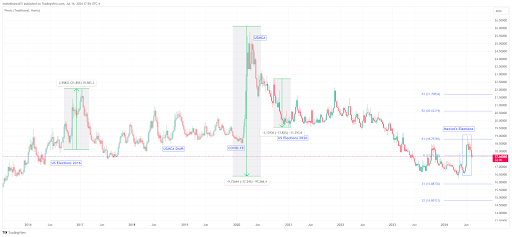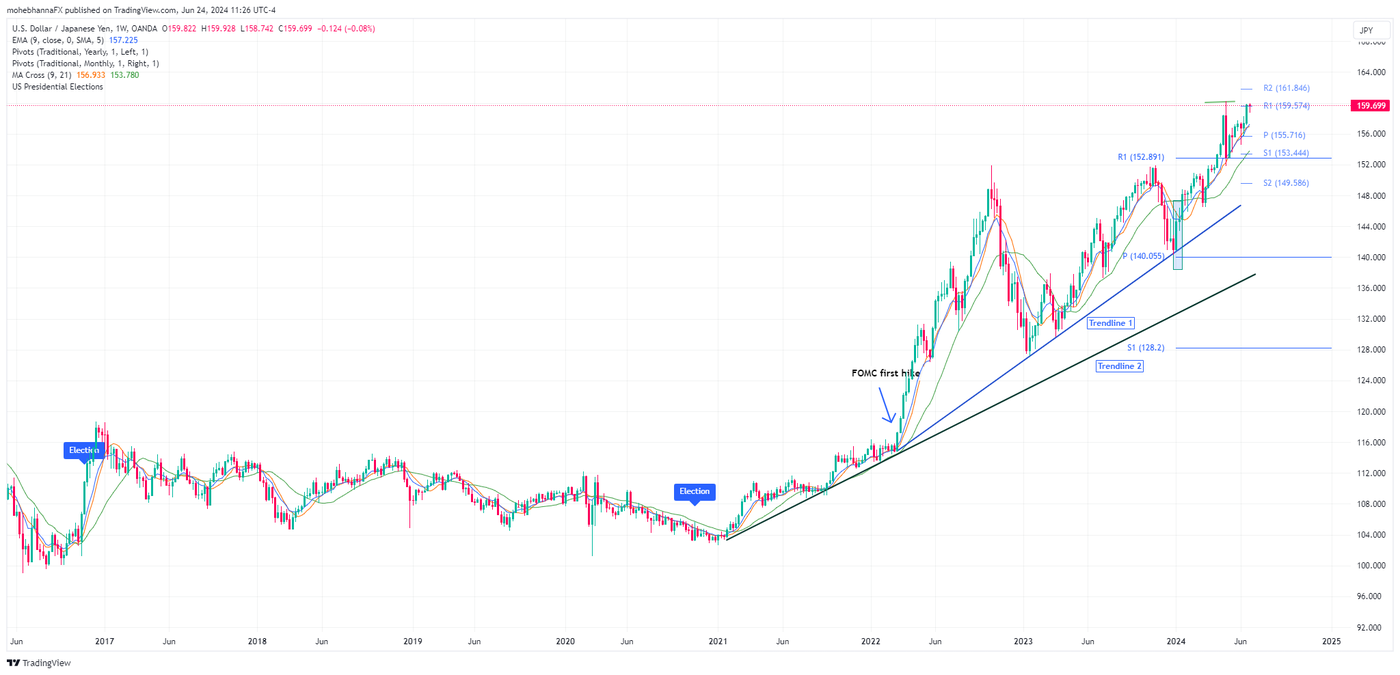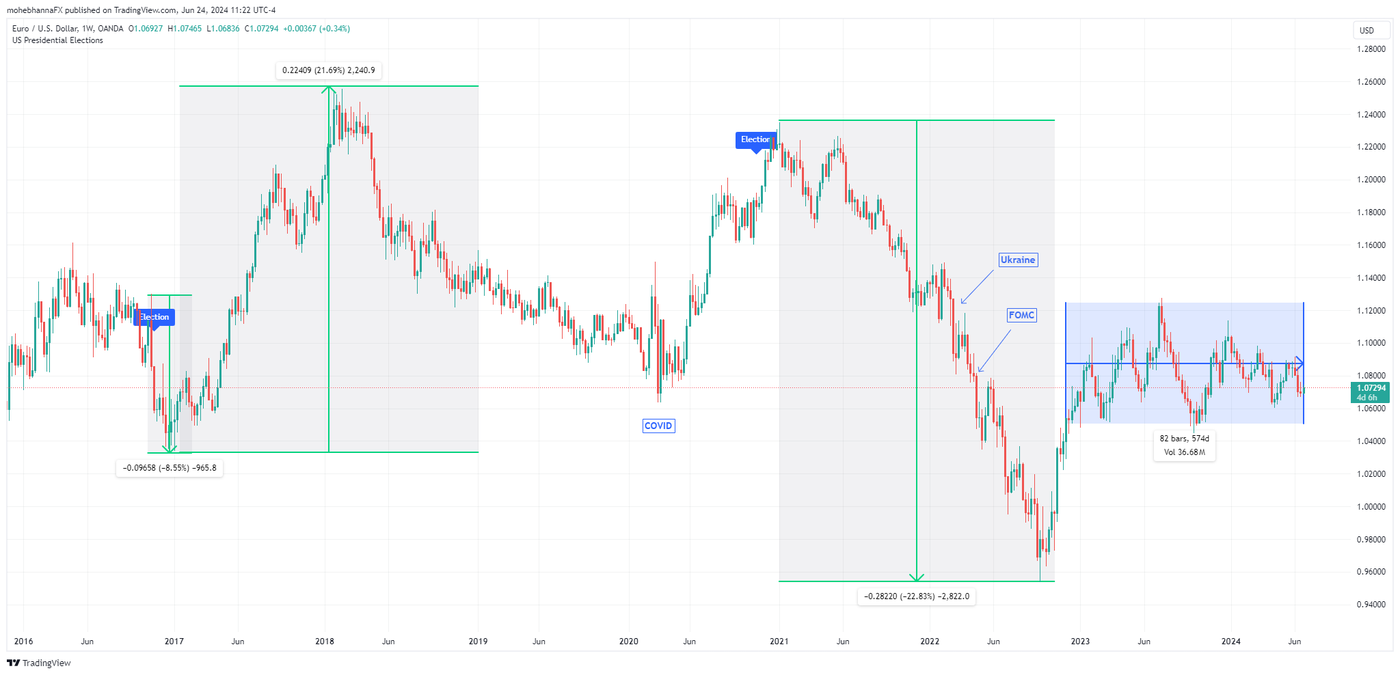The 2024 US presidential election could significantly impact currency markets. This article explores the economic factors influencing the election and analyzes four currency pairs (USD/MXN, USD/JPY, EUR/USD, and USD/CAD) likely to be most affected by election-related volatility. Discover potential trading opportunities and understand how economic policies and market sentiment may shape currency movements in the lead-up to November 2024.
Editor's note:
This article has been updated to reflect recent events in the Presidential race. The original article was originally written by Mohen Hanna and published on July 26, 2024.
Learn more about the US Election and Financial Markets.
Which economic factors may influence the outcome of the November 2024 US Presidential elections?
The US Presidential elections are approaching, and although there are many political and societal factors that may determine the outcome of an election, November 2024 may be affected by economic factors. Voters are closely monitoring the economy due to the high inflation experienced in the aftermath of COVID-19. To combat inflation, the Federal Reserve has raised interest rates 11 times since April 2022. Although inflation has declined from its 2022 peak, it remains a concern in certain sectors.
In a year where monetary policy decisions by world central banks continue to dominate headlines, the US Federal Reserve has only recently made its first cut since 2020, cutting rates by a staggering 50 basis points. This more ‘cautious’ approach contrasts those of the European Central Bank and the Bank of Canada, who opted to reduce interest rates much earlier in the year following a steady decline in inflation indicators.
In the post-COVID period, the US has experienced strong economic growth and a robust job market, outperforming global economies. Recent data, however, indicates that Americans are spending more cautiously, seeking bargains, and reducing leisure spending.
Which currency pairs are likely to be most affected by the volatility surrounding the US presidential election?
As the world’s reserve currency, the US dollar often experiences fluctuations in value due to various factors. This volatility is expected to increase around the US elections as global currencies and commodities are priced against the dollar. Moreover, the Federal Reserve's November meeting, scheduled during the election week, will likely amplify market volatility due to anticipated interest rate decisions and economic announcements.
The anticipated market volatility surrounding the election may present diverse trading opportunities across various currency pairs and timeframes. Prolonged uncertainty or delayed election results could extend this period of heightened volatility, potentially offering even more trading prospects. As we approach the November 2024 presidential election, traders are likely anticipating numerous election-driven trading opportunities in the currency markets. Some traders may also position themselves ahead of the election, therefore, volatility may have already started.
1. USD/MXN: Price action during 2016 and 2020 US elections, Mexico's elections, USMCA agreement and COVID-19
The Mexican peso has been a strong performer over the past two years, primarily due to high interest rates, economic growth, and increased cooperation with US businesses. This has presented a significant carry trade opportunity, with Mexico's interest rate at 11.25% compared to the US dollar's 5.50%. Although the peso has experienced fluctuations, including a 37% rise against the USD from March 2020 to July 2023 and a subsequent rebound to 18.10 in June 2024, it remains an attractive investment for some investors. Pre-election positioning, driven by factors like interest rate differentials and differing inflation rates between the two countries, may influence the USD/MXN exchange rate. Historical trends show varying peso responses to US elections, with potential implications depending on whether Harris or Trump wins. While Harris's win might maintain the status quo, Trump’s win could reintroduce tariff concerns. Additionally, Mexico's strong economic ties with the US, particularly through the USMCA, add another layer of complexity to the USD/MXN relationship.
2. USD/JPY: Price action during 2016 and 2020 US elections, FOMC Interest Rate hikes and Bank of Japan intervention
In March 2024, the Bank of Japan (BOJ) concluded its extensive monetary easing program, including its negative interest rate policies, which had been in place for over eight years. The central bank maintained its interest rate at 0.10%. Traders are now closely watching for any signals from the BOJ regarding quantitative tightening (QT), as the bank is expected to gradually reduce its bond holdings. This process, if not carefully managed, could potentially disrupt the market. To mitigate this, the BOJ might opt to reduce bond purchases at a slower rate than their holding expiration, a strategy requiring cautious execution.
The Japanese yen is currently trading near its lowest point versus the dollar in 38 years, and at a level not seen since 1986, worrying traders.Despite both the US and Japan maintaining their interest rates for a prolonged period, the yen has continued to weaken against the dollar, contributing to market uncertainty. As a result, and in a measure to stop ‘excessive fluctuations driven by speculation’, the Bank of Japan is known to have intervened at least once in recent history, aiming to prop up yen prices. Owing to abnormalities in price action, some traders have speculated that market intervention has happened more than just once, but the BoJ has yet to officially confirm.
Although the BOJ is in a rate-raising mode and the Fed is expected to cut rates, the interest rate differential between the US dollar and the Japanese yen remains appealing. Carry trades on USD/JPY can still offer returns for long-term investors, though these returns may be lower than other carry trade opportunities. However, they might also involve less risk compared to other available carry trade pairs.
3. EUR/USD: Price action during 2016 and 2020 US elections
The EUR/USD is the most frequently traded currency pair in the foreign exchange markets. During events that impact global markets, like the US elections, the euro tends to be more susceptible to market risks. This is primarily due to changes in US interest rates affecting the US dollar, rather than the euro itself. EU inflation has seen a recent uptick in May 2024, rising to 2.6% year-on-year, primarily driven by energy costs. This follows a period of steady decline since its peak in March/April 2022. The ECB, having already reduced interest rates by 25 basis points on June 6th, 2024, is now faced with the challenge of balancing inflation control with potential future rate cuts. The latest inflation increase, while bringing the indicator closer to pre-pandemic averages, adds complexity to the ECB's decision-making process.
Historically, the euro has reacted to shifts in US leadership. It initially declined under Trump's presidency, falling 8.5% to 1.0320. However, it later rebounded, reaching 1.2550 against the dollar. A sharp drop occurred in early 2018, finding support above 1.0600 during COVID-19, followed by another rise to 1.2200. With Biden's inauguration and the onset of the Ukraine war, coupled with FOMC interest rate hikes, the euro experienced a significant decline of 22.80%, reaching below parity at 0.9600. It has since partially recovered, trading within the 1.0550 – 1.1200 range in early 2023.
4. USD/CAD: Price action during 2016 and 2020 US elections, USMCA agreement and COVID-19
Canada, a major economic partner of the USA, has a highly correlated economy. The USD/CAD exchange rate is influenced by interest rates in both countries and oil prices, as Canada is a significant oil producer and a member of OPEC+. As Trump took office in January 2017, and when Biden did in January 2021, the Canadian dollar rose significantly against the US dollar as an initial reaction, and in both cases, the exchange price returned to its pre-election levels. Under the Trump administration, the USD/CAD rate remained relatively stable during the negotiation and implementation of the United States-Mexico-Canada Agreement (USMCA), which took effect on July 1st, 2020. However, anticipatory market positioning was evident before that.
Canadian inflation has followed global trends, rising post-COVID and then declining sharply after peaking around 8% in mid-2022. By early 2024, key inflation measures remained below 3%. This decline, coupled with weaker-than-expected economic growth, led to anticipation of the Bank of Canada's actions. On June 5th, 2024, the Bank of Canada became the first to cut interest rates by 25 basis points. Governor Tiff Macklem emphasized data-driven decision-making for future adjustments.
Despite strong retail sales over the past five years, recent months have shown a decline in specific categories, suggesting consumer caution and potential delays in interest-sensitive purchases. This trend is noteworthy as it coincides with a slowdown in Canada's GDP growth since late 2021.
Trade fundamental news events with OANDA
Looking to take advantage of potential market volatility ahead of the US Election?
Open an account with OANDA today to take advantage of powerful analysis tools and tight spreads on your favorite forex pairs.
Disclaimer
This article is for general information purposes only, not to be considered a recommendation or financial advice. Past performance is not indicative of future results.
Opinions are the author's; not necessarily that of OANDA Corporation or any of its affiliates, subsidiaries, officers or directors.
Leveraged trading in foreign currency contracts or other off-exchange products on margin carries a high level of risk and is not suitable for everyone. We advise you to carefully consider whether trading is appropriate for you in light of your personal circumstances. You may lose more than you invest. We recommend that you seek independent financial advice and ensure you fully understand the risks involved before trading.











